Freedom on the Fence: A Film on Polish Poster Art
A brief history of Polish Poster art
For more than a century, Polish Poster art painted a chronology of Poland’s social, political, and historic landscape. By the end of World War II, eight out of every ten buildings in Warsaw was destroyed. The Stalinist era marked an artistic shift to Socio-Realism, a movement which depicted social & racial injustice and economic hardship. From the 50s into the 80s, cultural events such as film, opera, and theatre became the impetus behind the memorable poster work. This was a period that became known as the Polish School of Posters, a time when the Communist State maintained a strict censorship policy on all printed media. In expression of their opposition, Polish artists created posters of irony, surrealism, and elements of abstraction, setting a new path for artistic innovation and international admiration. Warsaw, gray and crumbled by destruction, served as a backdrop to the miles of colorful posters plastered onto construction fences; fences of posters that would represent Poland’s struggle for unbridled freedom.
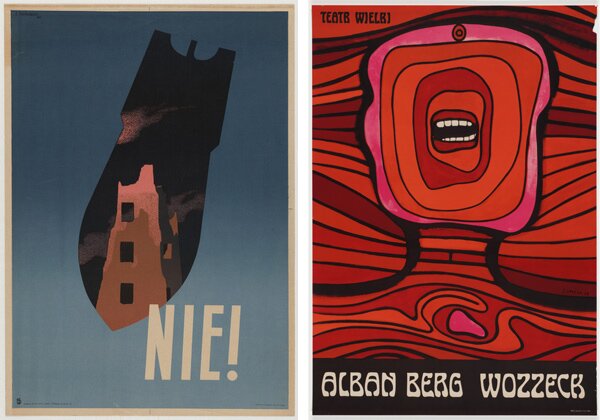
Left: Tadeuz Trepkowski Nie! (1952); Right: Jan Lenica Wozzeck (1964)
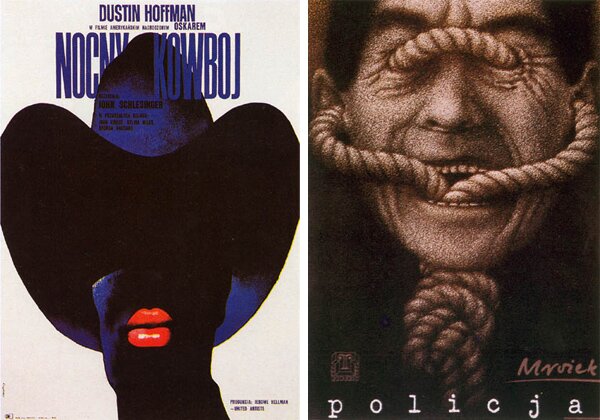
Left: Waldemar Świerzy - Midnight Cowbow (1973); Right: Mieczysław Górowski - Police (1982)
Freedom on the Fence
The documentary Freedom on the Fence, directed by Andrea Marks and Glenn Holsten, captures the paradox of how this unique art form flourished within a Communist regime. The film has been shown at several film festivals including the Santa Fe Film Festival and the Los Angeles Polish Film Festival. The documentary is being shown as part of an exhibit at the Museum of Modern Art in New York City, running from May 2009 through November 2009.
Every kind of restriction brings creativity. – Rafal Olbinski
Interview with Andrea Marks
 Andrea Marks is currently an Associate Professor and the coordinator of the Graphic Design program at Oregon State University. She received a BFA in graphic design from University of the Arts in Philadelphia and did her post-graduate work at the Basel School of Design in Basel, Switzerland. Her interests in design curriculum extend to exploring new ways in which students engage in learning. Her ebook Writing for Visual Thinkers was published in 2008 by AIGA/New Riders Press, and explores the many ways artists and designers can use writing in their work.
Andrea Marks is currently an Associate Professor and the coordinator of the Graphic Design program at Oregon State University. She received a BFA in graphic design from University of the Arts in Philadelphia and did her post-graduate work at the Basel School of Design in Basel, Switzerland. Her interests in design curriculum extend to exploring new ways in which students engage in learning. Her ebook Writing for Visual Thinkers was published in 2008 by AIGA/New Riders Press, and explores the many ways artists and designers can use writing in their work.
I spoke with Andrea Marks about the documentary, what inspired her, and her own challenges in making the film.
Why Polish posters?
I am often asked this question. I first became aware of Polish posters through a former Polish student of mine at Oregon State University named Anka Kolodziej. She and I worked on an exchange project together between graphic design students at OSU and students at the Warsaw Academy of Art. Students in both schools created posters on the theme of air and water and then sent them to one another’s school for an exhibition. It was during this time that Anka introduced me to some of her books on Polish posters. Not only were the posters amazing visually, but I also found the story of how and why these posters flourished in Communist Poland very interesting.
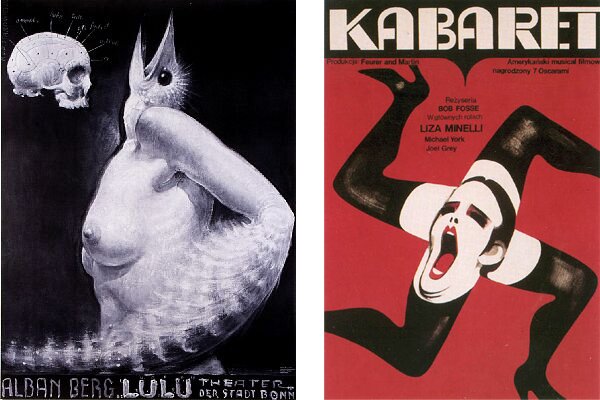
Left: Franciszek Starowieyski - Lulu (1980); Right: Wiktor Górka - Cabaret (1973)
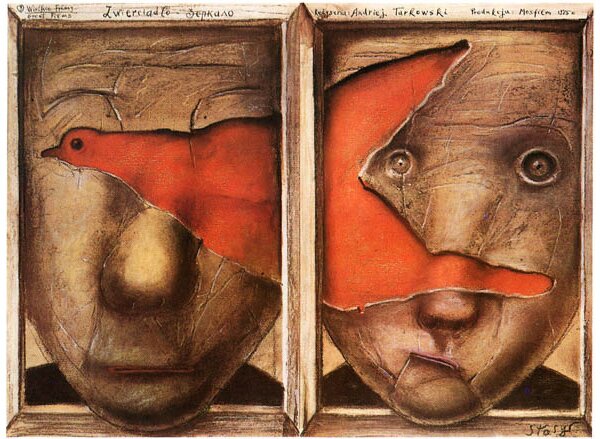
Stasys Eidrigevicius - Film Poster, Zwierciadło (Reflection) 1989
How did you prepare and research for the film?
Since I am a graphic designer by training and had not made a film before, I contacted Glenn Holsten, a friend of mine who is an independent filmmaker in Philadelphia. I pitched the story to him and he was interested in collaborating. I read a few articles and looked over the books Anka provided, but I soon realized that I needed to go to Poland to meet the artists and see if they were interested in being part of the film. I also wanted to make sure the story was interesting enough for a documentary. In 1998, I applied for a grant from IREX, an international grant organization, for funds to travel to Poland for a pre-production trip, and with the $2,500 grant, three of us traveled to Poland for an intensive two-week trip to meet artists. The mistake we made was going there in November, one of the coldest and grayest months. I knew that when we eventually returned to shoot the final film, we absolutely needed to return in the summer! Glenn brought a very low-end video camera and shot footage that was useful in creating a short presentation. My thought all along with this project was that it could take some time and it was important to have visual presentations at each stage. I used these presentations (a combination of video and multimedia) to give lectures on the topic and also for fundraising purposes. I think it is very important when embarking on a large and complex project to make short-term goals. This can help give you a sense of accomplishment along the way and also create interest for your project.
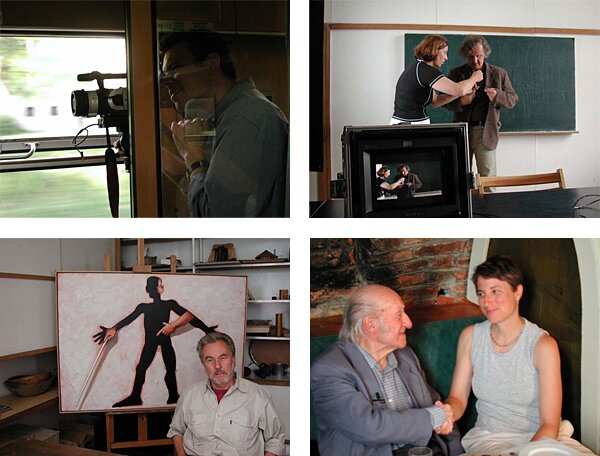
What kind of equipment and software did you use to shoot and edit the footage?
It actually took three more years to raise the money to shoot the final footage. I returned to Poland in the summer of 2002, with Glenn and Jeff Hino, another friend who is a videographer at my university. In order to keep costs down and make travel easier, we shot the Poland footage with a small Canon Digital camera and rented a set of lights and a monitor in Warsaw. Editing was done for the most part in Final Cut Pro.
What were some of the key challenges faced before, during and after the filming?
I am a graphic designer, so a key challenge for me was to learn about the various steps necessary in making a film. As producer of the film, I had to also figure out how to raise money for travel and production. Logistics were challenging in Poland. Neither Glenn or I speak Polish, so we had to hire a translator and it was a bit tricky organizing meeting meetings and interviews with artists. All of my interviews were done with a translator I hired in Poland and then I had to transcribe all interviews on paper. It was an incredibly tedious process that took dozens of hours, but it was the only way I could view the various voices and understand how to string these voices together to tell a story. Archival footage was an important element in the film and I hadn’t realized the expense before developing the story. Funds for the film were raised year by year and some years were better than others, so it was sometimes difficult to keep momentum going with the project year to year. Now that the film is done, the challenge has been finding the best avenue for independent marketing and distribution. The internet has been enormously helpful in getting the word out on the status of the film. I continue to receive emails from all over the world asking to be put on the mailing list when the film is released.
In what ways has this experience shaped your creative outlook and/or teachings?
As cliché as this may sound, I think the story of the Polish poster shows the strength of the human spirit, and it’s great to share that with my students. Polish posters gained international recognition for many reasons. On one level, these posters can be viewed for their pure, imagistic beauty. Students are typically very inspired by the visual strength of the Polish posters. I think the fact that they were drawn and painted, including the typography, speaks to the students of today. For many students, the idea of working off the computer on a poster is a bit of revelation. The next level is the content of the posters. Though these are for the most part cultural posters, announcing theater, film, opera, etc., the message on the poster is never literal. In fact, the posters are wonderful examples of how not to be literal, as they use metaphor, irony, satire and humor in very clever ways. The third level is examining the history and how the time period played a pivotal role in the development of these powerful posters. One might say that the added constraints of Communism and the fact that each poster had to go before a censor board pushed the artists to dig a little deeper. These are all inspirational pieces that I have taken away from the project and I share with my students.
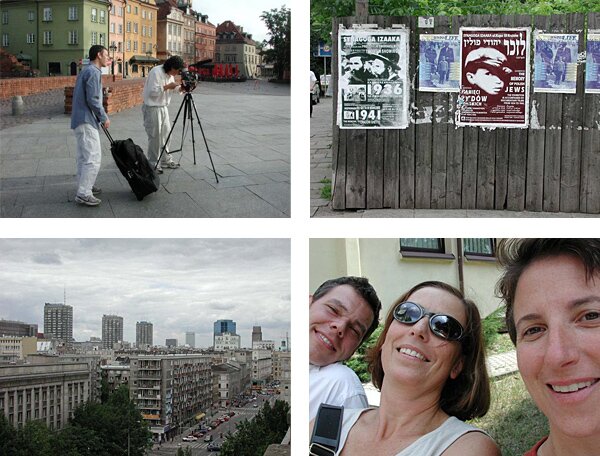
What are you hoping to achieve with your film?
My intent was always to create a documentary for historic preservation, as the Fall of Communism brought radical changes to the Polish poster. Once cultural institutions became privatized, the numbers of posters commissioned really dwindled. I knew that the first generation of poster artists were also aging. Two of the older artists I interviewed, Wiktor Gorka and Henryk Tomaszewski have since passed away, and I feel very fortunate to have met them and documented their words. In fact, I may have had the last interview with Tomaszweski, one of the most influential artists in the history of the Polish posters. I think the film gives a glimpse into an important historical period that students may know little about. The film begins with black and white footage of the destruction of Warsaw during WWII. This is sobering stuff to watch, and helps set up the context for how these powerful posters sprung up on the streets. I also think the film works very well when shown in conjunction with an exhibition of Polish posters and I have realized that there is still an amazing amount of interest in Polish posters. The film is currently being shown with an exhibition of polish posters at the Museum of Modern Art in New York City through the end of November, 2009.
When will Freedom on the Fence be released?
The film will be released within the first couple of weeks of October and can be purchased from the website freedomonthefence.com. It has also been shown at several film festivals over the past year.
Any plans in the future for another film?
At this point, I am just working on keeping up with screenings, presentations and marketing of the film and haven’t given much thought to another project. Having said that, I do think there are so many great stories out there to be told about art and design and it is exciting to think about the possibilities of documenting them.

Christy Lai is the co-founder and creative director at Colorcubic, a multidisciplinary design studio. She also runs a music label called Nueva Forma, and enjoys mid-century modern furniture, breakfast for dinner, and occasionally, sleep. You can also follow Christy on .


This is such a great concept. Last year, I took an illustration class and my professor spoke about how influential the mid century Polish Posters are in the history of art and propaganda. The idea’s that were thought of are visually astonishing. The posters really got there job done, due to the fact that they are visually shocking to the eyes and the heart.
www/lesaffiches.com present more that 500 polish posters
This move will assist in several methods – first the professional has considerable data and expertise about involved product, secondly, he might have some contacts with some suppliers which is able to make it easier to in clinching one of the best deals in shopping for process plant equipment and equipments.